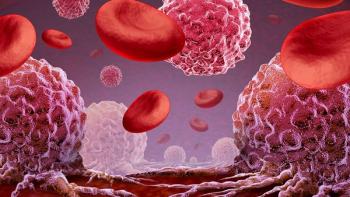Treatment with Rina-S (rinatabart sesutecan) led to a 50% confirmed response rate, including two complete responses, in heavily pretreated advanced endometrial cancer, according to a news release from Genmab.
“Advanced stage and recurrent endometrial cancer often lead to resistance to standard of care options. When this occurs, prognosis worsens and treatment options become increasingly limited, leaving patients and clinicians to navigate difficult decisions,” Dr. Ira Winer said in the release. “These phase 1/2 results demonstrate encouraging data with Rina-S in this patient population and support its further development as a potential therapy for patients with advanced and recurrent endometrial cancer.”
Winer is the study investigator and a professor in the Division of Gynecologic Oncology and Phase I Developmental Therapeutics at the Karmanos Cancer Institute, Wayne State University, located in Detroit, Michigan.
Glossary:
Antibody-drug conjugate (ADC): a targeted cancer therapy that links an antibody to a chemotherapy drug, delivering treatment directly to cancer cells.
Objective response rate (ORR): percentage of patients whose cancer shrinks or disappears after treatment, confirmed by follow-up scans.
Complete response (CR): disappearance of all signs of cancer in response to treatment.
Median follow-up: the middle length of time patients has been observed after starting treatment.
Median duration of response: the middle length of time patients maintains cancer control after first responding to treatment.
After a median follow-up of 7.7 months, treatment with Rina-S every three weeks led to a 50% confirmed objective response rate, including two complete responses, among heavily pretreated patients with advanced endometrial cancer who had experienced disease progression following platinum-based chemotherapy and an immune checkpoint inhibitor. Median duration of response has not yet been reached.
Patients received either 100 milligrams per square meter (mg/m2) (22 patients) or 120 mg/m2 (42 patients) of the agent. Among those given 100 mg/m2, the confirmed overall response rate was 50%, including two complete responses. In the 120 mg/m2 group, the confirmed response rate was 47.1%, also demonstrating anti-tumor activity. Median duration of response had not yet been reached at the time of analysis, with a median follow-up of 7.7 months in the 100 mg/m2 group and 9.8 months in the 120 mg/m2 group. Median ages were 67 and 69.5 years in the respective cohorts, and patients had received a median of three prior treatments.
Presented at the 2025 ASCO Annual Meeting in Chicago, Illinois, these data came from the endometrial cancer monotherapy dose expansion B2 cohort of the multi-part RAINFOL-01 trial, which is evaluating the safety and efficacy of Rina-S in solid tumors.
Rina-S was evaluated in 64 patients with advanced or recurrent endometrial cancer that had progressed following treatment with both anti-PD-(L)1 therapy and platinum-based chemotherapy.
Common treatment-related side effects of any grade included diarrhea, shortness of breath, urinary tract infection, headache, constipation, decreased appetite, vomiting, fatigue and nausea. Serious side effects (grade 3 [severe] or higher) occurred in 32% of patients treated with Rina-S 100 mg/m² and 50% of those who received 120 mg/m². Blood-related side effects were manageable without major dose reductions and led to few treatment discontinuations. No signs of eye problems, nerve damage or interstitial lung disease — side effects sometimes linked to antibody-drug conjugates — were observed.
“Rina-S represents the kind of innovation that defines our focus at Genmab, which is to develop wholly owned, novel antibody-based medicines that have the potential to transform the treatment of cancer and address an unmet need, including for patients with advanced endometrial cancer,” Dr. Judith Klimovsky, executive vice president and chief development officer of Genmab, said in the news release. “The encouraging early signals in endometrial cancer underscore our deep commitment to making a meaningful impact for women with gynecologic cancers, where treatment advances have long lagged behind the need.”
What is Rina-S?
Rina-S is an investigational antibody-drug conjugate targeting folate receptor α (FRα), which is a protein often found on certain cancer cells. The drug combines a monoclonal antibody, a protease-cleavable linker, and exatecan, a chemotherapy payload that inhibits topoisomerase I. Rina-S is being studied in multiple cancers with limited treatment options, including ovarian and endometrial cancer.
In January 2024, it received fast track designation from the Food and Drug Administration for use in patients with FRα-expressing platinum-resistant ovarian cancer. Late-stage development is underway, including ongoing evaluation in the RAINFOL-01 trial and a planned phase 3 study in endometrial cancer. Rina-S is still investigational, and its safety and efficacy have not been established.
For more news on cancer updates, research and education, don’t forget to subscribe to CURE®’s newsletters here.







